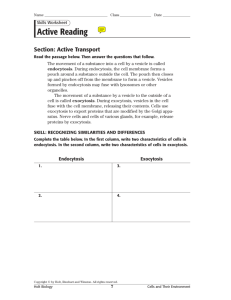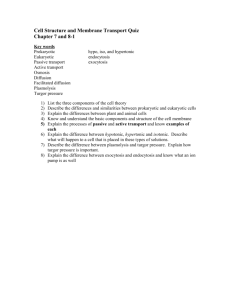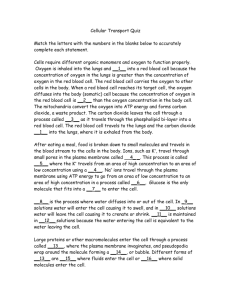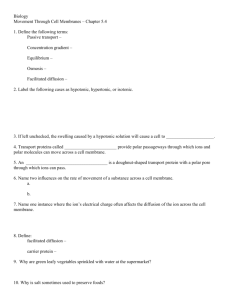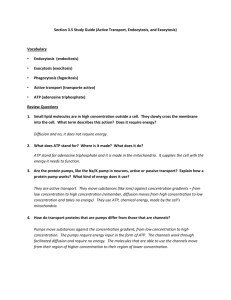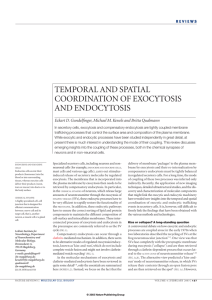Ch3 Sec5 IR Active Transport
advertisement
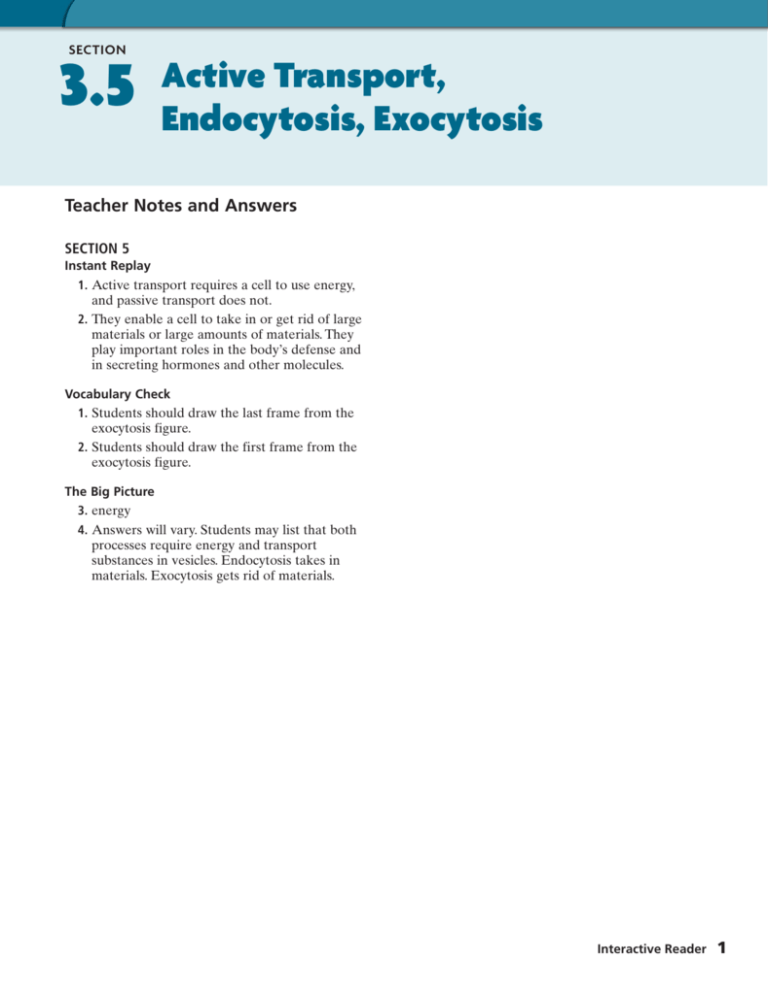
section 3.5 Active Transport, Endocytosis, Exocytosis Teacher Notes and Answers SECTION 5 Instant Replay 1.Active transport requires a cell to use energy, and passive transport does not. 2.They enable a cell to take in or get rid of large materials or large amounts of materials. They play important roles in the body’s defense and in secreting hormones and other molecules. Vocabulary Check 1.Students should draw the last frame from the exocytosis figure. 2.Students should draw the first frame from the exocytosis figure. The Big Picture 3.energy 4.Answers will vary. Students may list that both processes require energy and transport substances in vesicles. Endocytosis takes in materials. Exocytosis gets rid of materials. Interactive Reader 1 section 3.5 Active Transport, Endocytosis, Exocytosis Key Concept Cells use energy to transport materials that cannot diffuse across a membrane. Proteins can transport materials against a concentration gradient. You have seen that the cell membrane controls the passive transport of materials into and out of a cell. However, cells often need large amounts of materials that cannot diffuse across the membrane. Cells can use energy to move molecules from an area of lower concentration to an area of higher concentration. This process is called active transport. As the figure shows, active transport uses energy to drive molecules through transport proteins. This process plays an important role in helping cells to maintain homeostasis. What is the difference between active transport and passive transport? outside energy During active transport, a cell uses energy to move substances against a concentration gradient—that is, from a lower to a higher concentration. Endocytosis and exocytosis transport materials across the membrane in vesicles. Sometimes a material is too large to cross the membrane. Cells can use energy to transport these materials in vesicles. A cell uses endocytosis to take in large materials or liquids. The prefix endo- means “in.” In endocytosis, the cell membrane starts to fold in, forming a pocket around a substance. The pocket breaks off inside the cell, making a vesicle. The contents of the vesicle are then broken down or released into the cell. Phagocytosis (fag-uh-sy-toh-sihs) is a type of endocytosis in which the cell membrane grows out to surround large particles. The word literally means “cell eating.” Phagocytosis plays an important role in the immune system when white blood cells “eat” bacteria and other invaders. 2 1 2 3 The cell membrane folds inward, enclosing the substance in a pocket. The pocket pinches off inside the cell, forming a vesicle. The vesicle fuses with a lysosome, where enzymes break it down. McDougal Littell Biology inside Exocytosis is the opposite of endocytosis. The prefix exo- means “out.” It is the process that moves substances out of the cell. In exocytosis, a vesicle surrounds materials that need to be removed. The vesicle then goes to the cell membrane, fuses with it, and lets go of the contents. Exocytosis is the cell’s way of getting rid of wastes or secreting molecules. 1 2 3 The cell forms a vesicle around material that needs to be removed or secreted. The vesicle is transported to the cell membrane. The vesicle membrane fuses with the cell membrane and releases the contents. What functions do endocytosis and exocytosis carry out for the cell? 3.5 Vocabulary Check active transport endocytosis phagocytosis exocytosis 1. Draw the last step of exocytosis at right. Mark It Up Go back and highlight each sentence that has a vocabulary word in bold. 1. 2. 2. Draw the first step of endocytosis at right. 3.5 The Big Picture 3. The biggest difference between active transport and passive transport is the need for the cell to use . 4. Draw a Venn diagram in the space to the right to compare and contrast exocytosis and endocytosis. Interactive Reader 3
